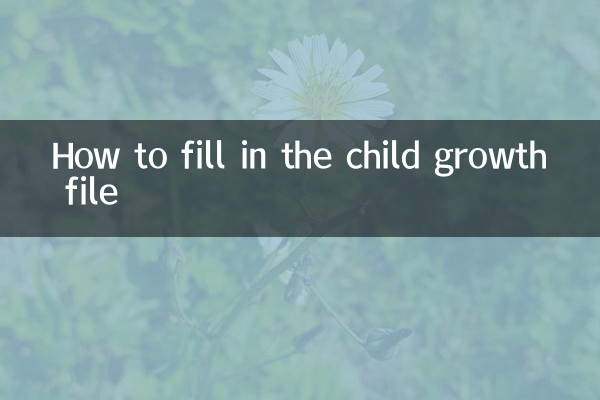How to fill in the child growth file
Child growth files are an important tool for recording children's growth process and can help parents and teachers fully understand their children's development. Among the hot topics in the past 10 days, discussions about early childhood education have remained hot, especially how to scientifically fill in growth files has become the focus. This article will provide you with a detailed filling guide based on recent hot topics.
1. The importance of children’s growth files

Children's growth files are not only witnesses of children's growth, but also an important basis for educational evaluation. Through the archives, parents and teachers can track the progress of their children's physical and mental development, learning ability, and social interaction, and adjust educational strategies in a timely manner.
2. Main contents of children’s growth files
The following is the core content that needs to be included in the child development profile:
| Category | Specific content |
|---|---|
| Basic information | Name, gender, date of birth, family contact information, etc. |
| physical development | Height, weight, health status, athletic ability, etc. |
| cognitive development | Language ability, mathematical thinking, observation, memory, etc. |
| emotion and sociality | Emotional management, peer interaction, rule awareness, etc. |
| Art and Creativity | Artistic expressions such as painting, music, and handicrafts |
3. How to scientifically fill in children’s growth files
1.Regular records:It is recommended to update the archive content regularly on a weekly or monthly basis to avoid missing important information.
2.Objective description:Avoid subjective evaluations and try to use specific examples to describe your child's behavior and development. For example: "The child can independently complete a 10-piece puzzle" is more valuable than "The child is very smart".
3.Multi-dimensional assessment:Comprehensive recording from physical, cognitive, emotional, social and other aspects to avoid one-sidedness.
4.Combination of pictures and text:You can attach your child's works, photos of activities, etc. to make the file more vivid.
4. Relevant suggestions on recent hot topics
Based on the hot topics in education in the past 10 days, the following are the points that parents and teachers are particularly concerned about:
| hot topics | Inspiration for filling in growth files |
|---|---|
| Early Childhood Mental Health | Increased record of emotional management and psychological adaptability |
| STEM education | Pay attention to children’s scientific inquiry and problem-solving abilities |
| outdoor activities | Document your child’s exploration and discovery in the natural environment |
| Parent-child interaction | Increase observation records of the impact of family activities on children |
5. Frequently Asked Questions
1.Who should fill out the growth profile?
Ideally, this should be done jointly by parents and teachers. Parents are responsible for recording performance in the home environment, and teachers record attendance at school.
2.How often should archiving be done?
It is recommended that the system records at least once a month, and important milestones can be added at any time.
3.Are electronic or paper files better?
Both have their advantages. Electronic files are easy to store and share, while paper files are more ceremonial. Can be used in combination.
6. Summary
Children's growth files are valuable assets on the way to children's growth. Scientific and systematic records can not only help educators better understand children, but also allow children to review their growth process in the future. Hopefully the structured guidance provided in this article will help you better accomplish this important educational task.
Final reminder: The core value of the growth archive is to truly reflect the child's growth process. There is no need to pursue perfection, but to truly record every meaningful moment.

check the details

check the details